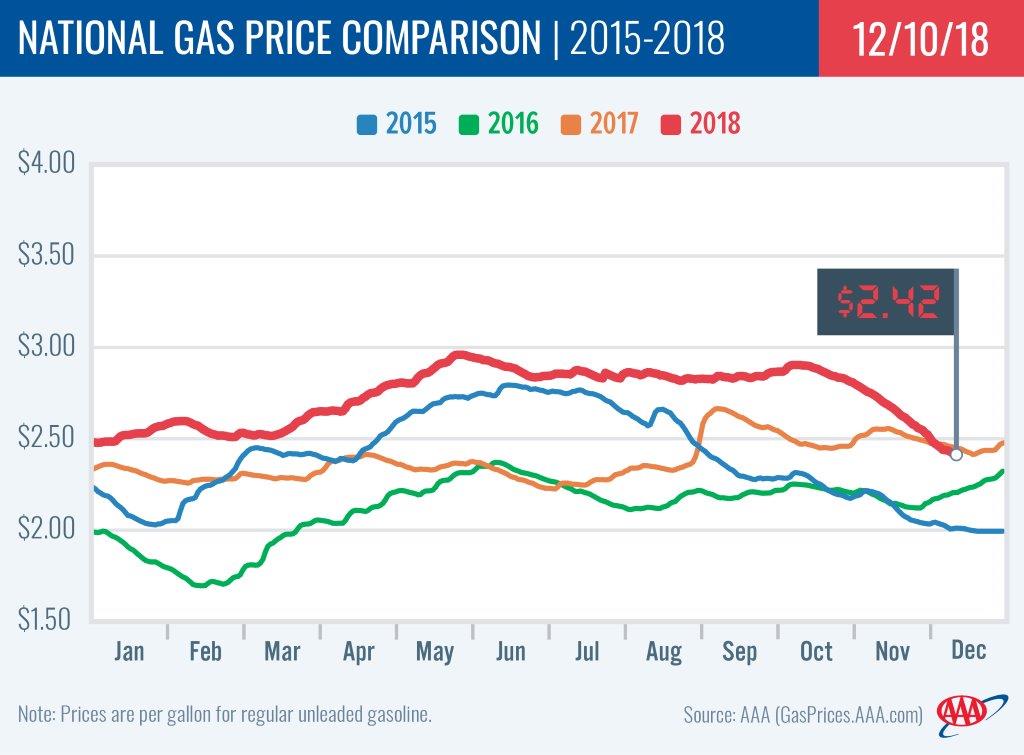AAA launches Fuel Rewards Program at Shell to help members save even more
PORTLAND, Ore., – Drivers are getting an early holiday gift in the form of lower pump prices. All 50 states are showing double-digit price drops in the last month. For the week, the national average for regular drops three cents to $2.41, the lowest price of the year, while Oregon’s average falls a nickel to $3.07, the lowest price since last March. Several Oregon markets have averages below $3 a gallon.
AAA members can save even more at the pumps with the new Fuel Rewards® Program offer at participating Shell stations nationwide. AAA members can save up to five cents per gallon through December 31, 2019. Another added benefit, members registering for the first time in the Fuel Rewards® program will save 25 cents per gallon on their first fill-up through January 31, 2019. Members just need to sign up at AAA.com/Shell.

“Cheaper crude oil prices, a glut of production and economic concerns are putting downward pressure on pump prices. And the new Fuel Rewards Program at Shell will have even more change jingling in AAA members’ pockets this holiday season,” says Marie Dodds, public affairs director for AAA Oregon/Idaho.
Oregon is one of 46 states and the District of Columbia where gas prices are lower week-over-week. Colorado has the largest weekly decrease (-8 cents). Michigan has the largest weekly increase (+7 cents). This week six states have averages at or above $3 a gallon, same as a week ago.
All 50 states and the District of Columbia have lower prices now than a month ago with all states seeing double-digit drops. The national average is 29 cents less and the Oregon average is 22 cents less than a month ago. Iowa has the largest monthly decrease (-39 cents). Wyoming has the smallest monthly decrease (-12 cents).
The West Coast continues to have the most expensive gas prices in the nation. Hawaii tops the list for the 27th week in a row with California, Washington, Alaska, Nevada, Oregon and Idaho rounding out the top seven. Oregon is sixth most expensive for the fourth week in a row. On the week, California has the largest drop of seven cents in the region.
| Rank | Region | Price on 12/11/18 | |
| 1 | Hawaii | $3.58 | |
| 2 | California | $3.44 | |
| 3 | Washington | $3.23 | |
| 4 | Alaska | $3.14 | |
| 5 | Nevada | $3.08 | |
| 6 | Oregon | $3.07 | |
| 7 | Idaho | $2.82 | |
| 8 | Utah | $2.80 | |
| 9 | Wyoming | $2.80 | |
| 10 | Arizona | $2.75 |
The U.S. Energy Information Administration’s weekly petroleum status report for the week ending on November 30, showed West Coast gasoline stocks increased by approximately 700,000 bbl to 27.7 million bbl. Stocks are approximately 2 million bbl lower than at this time last year, which could cause prices to spike if there is a supply challenge in the region this week.
The nation’s cheapest markets are Missouri ($1.99) and South Carolina ($2.06) and. This is the first time in 71 weeks where a state has an average below $2.
Oregon is one of 16 states and the District of Columbia where drivers are paying more than a year ago to fill up. The national average is five cents less and the Oregon average is 26 cents more than a year ago. This is the ninth-largest yearly increase in the country. Nevada (+40 cents) has the greatest year-over-year increase; Arizona (+38 cents) is second; Utah (+33 cents) is third; California (+31 cents) is fourth; and Wyoming (+31 cents) is fifth.
Oil Market Dynamics
Oil prices rallied at the end of last week after OPEC announced that beginning in January 2019, the cartel – alongside non-OPEC members, including Russia – will reduce combined crude oil production by 1.2 million b/d. The cut will be in place for six months and will use October 2018 as a baseline, a time when OPEC and Russia had less crude output than in November. With the announcement, crude prices will likely increase in 2019 ahead of the higher demand driving season next summer. Increased crude prices will likely lead to higher gas prices, given that approximately 50 percent of the cost motorists pay at the pump is based on the cost of crude used to make gasoline.
In related news, EIA’s report for the week ending on November 30 revealed that crude inventories decreased by 7.3 million bbl after 10 weeks of consecutive growth. Total domestic crude inventories now sit at 443.2 million bbl, which is approximately 5 million bbl less than their level at this time last year. Declining inventories contributed to the increase in crude prices this week, and if the trend continues, prices could climb further.
At the close of Friday’s formal trading session on the NYMEX, WTI increased $1.12 to settle at $52.61. At the close of Monday’s formal trading session on the NYMEX, WTI fell $1.61 to settle at $51.00. Today crude is trading around $52, compared to $53 a week ago. Crude prices are down about 12 percent in the last month and are about $6 per barrel lower than a year ago.
Drivers can find current gas prices along their route with the free AAA Mobile app for iPhone, iPad and Android. The app can also be used to map a route, find discounts, book a hotel and access AAA roadside assistance. Learn more at AAA.com/mobile.
Diesel
For the week, the national average falls four cents to $3.11 a gallon. Oregon’s average drops six cents to $3.28. A year ago the national average for diesel was $2.84 and the Oregon average was $3.01.
Find current fuel prices at GasPrices.AAA.com.
AAA news releases, high resolution images, broadcast-quality video, fact sheets and podcasts are available on the AAA NewsRoom at NewsRoom.AAA.com.



